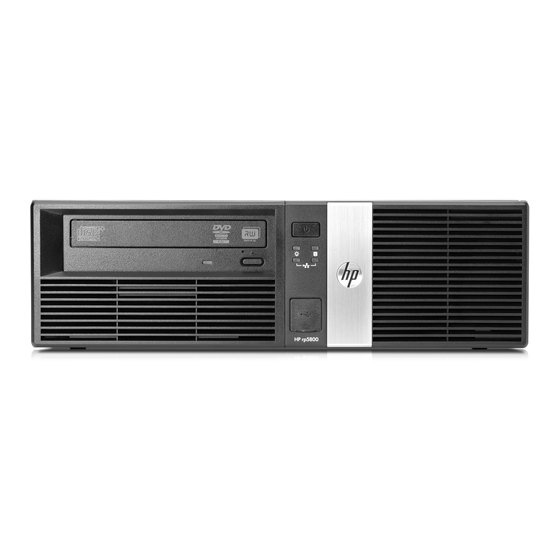
HP rp5800 Installation Manual
12v powered usb card installation guide
Hide thumbs
Also See for rp5800:
- Maintenance and service manual (185 pages) ,
- Reference manual (75 pages) ,
- Quickspecs (51 pages)
Advertisement
Quick Links
12V Powered USB Card
Installation Guide
HP rp5800 Retail System
© Copyright 2011 Hewlett-Packard Development Company, L.P. The
information contained herein is subject to change without notice.The only
warranties for HP products and services are set forth in the express warranty
statements accompanying such products and services. Nothing herein should
be construed as constituting an additional warranty. HP shall not be liable for
technical or editorial errors or omissions contained herein.
Printed in
First Edition: May 201 1
Before You Begin
Before installing the Powered USB card be sure to power off the rp5800
and disconnect the power cord from the power outlet.
WARNING! To avoid the risk of serious injury, ensure that the
power cord is unplugged from the electrical outlet at the wall
before installing the card. Failure to do so may expose you to the
risk of electric shock.
CAUTION: To avoid the risk of damage to the system, ensure that
the power cord is unplugged from the electrical outlet at the wall
before installing the card.
NOTE: You can install the Powered USB expansion card in the PCI
Express x1 slot or the PCI Express x16 slot, or both. Two 12-volt
Powered USB expansion cards are supported.
Installing the Card
1.
Turn off power to the system and disconnect the power cord from
the power outlet.
2.
Slide the access panel handle toward the rear of the computer 1
then lift the access panel up and off the computer 2.
3.
Release the half-height slot cover retention latch by lifting the
green tab on the latch and rotating the latch to the open position.
4.
Remove the appropriate expansion slot cover on the back of the
chassis. Pull the slot cover straight up then away from the inside of
the chassis.
5.
Hold the card just above the PCI Express expansion socket on the
system board then align the bracket on the card with the open slot
on the rear of the chassis 1. Press the card straight down into the
expansion socket on the system board 2.
NOTE: You can install the Powered USB expansion card in the PCI
Express x1 slot or the PCI Express x16 slot, or both. Two 12-volt
Powered USB expansion cards are supported.
6.
The cable included with the card has a single connector on one
end and dual connectors on the other end. Connect the single end
of the cable to the rear of the card 1. Connect the green
connector on the other end of the cable to the green 12-volt USB
connector on the system board 2. The cable will plug on one side
of the green connector only. Connect the black connector to one
of the two black 12-volt USB connectors on the system board 3.
NOTE: The system board connectors allow you to install two 12-
volt Powered USB expansion cards. The green connectors on the
system board are coupled together as one connector. The black
connectors on the system board are separate connectors.
7.
If you are installing two cards, connect the single end of each
cable to the rear of the cards 1. Connect the green connectors on
the other end of the cables to the green 12-volt USB connectors on
the system board that are coupled together 2. Connect the black
connectors to the two black 12-volt USB connectors on the system
board 3.
8.
Rotate the slot cover retention latch back in place to secure the
expansion card.
9.
Slide the lip on the front end of the access panel under the lip on
the front of the chassis 1 then press the back end of the access
panel onto the unit so that it locks into place 2.
10. Reconnect the power cord and any external devices, then turn on
the computer.
Advertisement

Summary of Contents for HP rp5800
- Page 1 Before You Begin Remove the appropriate expansion slot cover on the back of the Before installing the Powered USB card be sure to power off the rp5800 chassis. Pull the slot cover straight up then away from the inside of and disconnect the power cord from the power outlet.
- Page 2 European standards (European Norms) that are listed in the measures: • Italian EU Declaration of Conformity issued by HP for this product or product • Japanese • Reorient or relocate the receiving antenna.










